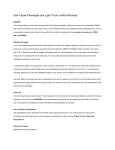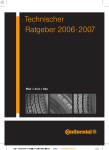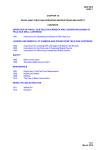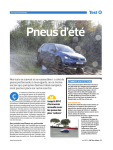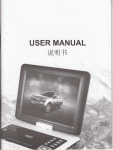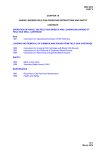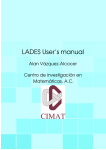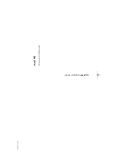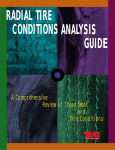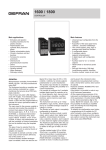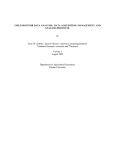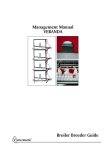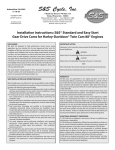Download Tyre Basics Passenger Car Tyres
Transcript
Tyre Basics Passenger Car Tyres 2008/09 Tyre Basics - Passenger Car Tyres Publisher's imprint The content of this publication is provided for information only and without responsibility. Continental AG makes no representations about the accuracy, reliability, completeness or timeliness of the information in this publication. Continental AG may, in its sole discretion, revise the information contained herein at any time without notice. Continental AG's obligations and responsibilities regarding its products are governed solely by the agreements under which they are sold. Unless other-wise agreed in writing, the information contained herein does not become part of these agreements. This publication does not contain any guarantee or agreed quality of Continental AG’s products or any warranty of merchantability, fitness for a particular purpose and non-infringement. Continental AG may make changes in the products or services described at any time without notice. This publication is provided on an “as is” basis. To the extent permitted by law, Continental AG makes no warranty, express or implied, and assumes no liability in connection with the use of the information contained in this publication. Continental AG is not liable for any direct, indirect, incidental, consequential or punitive damages arising out of the use of this publication. Information contained herein is not intended to announce product availability anywhere in the world. The trademarks, service marks and logos (the Trademarks) displayed in this publication are the property of Continental AG and/or its affiliates. Nothing in this publication should be construed as granting any license or right to the Trademarks. Without the express written consent of Continental AG the use of the Trademarks is prohibited. All text, images, graphics and other materials in this publication are subject to the copyright and other intellectual property rights of Continental AG and/or its affiliates. Continental AG owns the copyrights in the selection, coordination and arrangement of the materials in this publication. These materials may not be modified or copied for commercial use or distribution. Copyright © 2008 Continental AG All rights reserved. TDC 06/2008 0130 1567 2 Contents Introduction . . . . . . . . . . . . . . . . . . . . . . . . . . . . . . . . 4 Steps in the Development of the Pneumatic Tyre: Coming a Long Way . . . . . . . . . . . . . . . . . . . . . . . . . 5 The Inside Story Material inside a tyre . . . . . . . . . . . . . . . . . . . . . . . . 10 Tyre Components . . . . . . . . . . . . . . . . . . . . . . . . . . 11 Components and Their Functions . . . . . . . . . . . . . . 12 Tyre Production - A Glance Around the Factory . . . . . . . . . . . . . . . . 14 The Outside of a Tyre Information on the Sidewall. . . . . . . . . . . . . . . . . . . 18 Tread Pattern . . . . . . . . . . . . . . . . . . . . . . . . . . . . . 20 Tyre Tips Tyre Selection/Service Description . . . . . . . . . . . . . 22 Inflation Pressure . . . . . . . . . . . . . . . . . . . . . . . . . . 23 Winter Tyres . . . . . . . . . . . . . . . . . . . . . . . . . . . . . . 24 Tyre Storage . . . . . . . . . . . . . . . . . . . . . . . . . . . . . . 26 Wheels and Rims . . . . . . . . . . . . . . . . . . . . . . . . . . 27 3 Tyre Basics - Passenger Car Tyres Introduction The tyre is a complex technical component of today’s motor cars and must perform a variety of functions. It must cushion, dampen, assure good directional stability, and provide long-term service. Most important of all, however, it must be capable of transmitting strong longitudinal and lateral forces (during braking, acceler-ating and cornering manoeuvres) in order to assure optimal and reliable roadholding quality. It must be able to do all of this even when the road provides little traction in wet or slippery conditions or when the road is covered with snow or ice. In certain cases, these wide ranging demands leave tyre engineers no choice but to settle for a compromise between opposing characteristics. Vehicles with powerful engines require, for example, good grip – particularly on wet roads. On the other hand, a corresponding improvement in the tread compound can affect tyre life, rolling resistance and ride comfort (see diagram). One point, however, has absolute priority over all other tyre design objectives, and that’s safety. Conflicting goals in tyre development Compromises under wet braking conditions: Optimisation of a single aspect has an impact on several others. Directional stability Steering precision Tyre weight Ride comfort Service life Rolling resistance Wet braking Aquaplaning 4 Steps in the Development of the Pneumatic Tyre The wheel, as such, is not a natural phenomenon. And yet it wasn’t invented in the modern sense of the word. For more than 5,000 years, the wheel has been reinvent at different times and in different regions to meet current transportation needs. In its earliest forms, for example, used in Mesopotamia or ancient Egypt, the wheel was made as a solid disc with three segments held together by circular pieces of metal or leather. The principle of a disc revolving on an axis was known from pottery making – the wheel is thus an early example of technology transfer. (Contrary to wide misconception, the wheel did not evolve from the use of tree trunk slabs cut horizontally because they’re neither round nor durable enough for such purposes.) These awkward and clumsy wooden disc wheels were later developed into spoked wheels, but only for more superior vehicles like war or ritual chariots. Spoked wheels were lighter, stronger and more stable – but they were also much more technologically sophisticated. The felloes often had large-headed nails to prolong the wheel’s life. Spoked wooden wheels lasted until the modern era of coaches, and then usually with iron tyres. Even the first Benz motor car introduced in 1886, which was basically a motorised carriage, still had spoked wooden wheels, albeit with solid rubber tyres. Cross-section of a tyre around 1910 5 Tyre Basics - Passenger Car Tyres Steps in the Development of the Pneumatic Tyre The pneumatic tyre was invented later, firstly for bicycles (Dunlop 1888) and subsequently for automobiles. In 1898 Continental started producing so called “pneumatics”, tyres capable of giving a more comfortable (cushioned) ride and enabling automobiles to travel at higher speeds. 1924 Ballon Continental also made a significant contribution towards further technical advances of the pneumatic tyre: From 1904 onwards, tyres featured a tread pattern (see page 20) and were given their typical black colour. The addition of carbon black made tyres tougher and more durable. Around 1920 the cord tyre came from the U.S.A. (see page 7). This tyre had a body made of cotton cord which was more resilient, less susceptible to punctures, and longer-lasting. The low-pressure tyre or “balloon” (inflated at just under 3 bar instead of the previous 5 bar or more) was invented in the mid-1920s. It was followed in the 1940s by the “super balloon” tyre which had a larger volume of air and better comfort. 1948 Super-Ballon 1964 “82” Series 1967 “70” Series 1971 “60” Series 1975 “50” Series 1987 “45” Series 1993 “35” Series 1996 “30” Series 2002 “25” Series 6 In the early 1950s the steel radial tyre (see page 8) set new standards in mileage and handling performance. By 1970 the former cross-ply tyre had disappeared from the passenger car market (this didn’t apply to truck tyres however). Low profile tyres were invented at the same time, and 70% profile tyres were followed within just a few years by the 60% and 50% profile tyres (see illustration page 6). A height-width ratio of 65% is standard for many vehicles today and modern tyres are getting even wider – now having a height-width ratio as low as 25%. These ultra-low-profile tyres are, however, built for special high performance cars. The fact that tyres manufactured today by Continental are nothing less than high-tech products is made very clear by the following details: Since 1975 the maximum speeds possible with Continental tyres have risen from 210 km/h to 360 km/h while at the same time the weight of a tyre of average size has actually reduced from 11.6 kg to 8 kg. Modern passenger car radials are made of up to 25 different structural parts and as many as 12 different rubber compounds. The main structural elements are the casing and the tread/belt assembly. The casing cushions the tyre and contains the required volume of air. In fact, the air is the load carrier, not the tyre. The tread/belt assembly provides a minimal rolling resist-ance, optiml handling and a long service life.In the early days of tyre development, the casing was made of square woven linen fabric embedded in rubber. However, the crossed threads of the fabric cut away at each other, resulting in a relatively short tyre life. Square woven linen fabric This prompted Continental to introduce in 1923 a new cord fabric. This featured a unidirectional arrangement of cords held in place by supporting threads and embedded in rubber. Tyres incorporating the new fabric lasted much longer. Cords embedded in rubber 7 Tyre Basics - Passenger Car Tyres Steps in the Development of the Pneumatic Tyre Cross-ply tyres (until about 1970) The casing of a cross-ply tyre consists of a number of rubberised cord plies with edges wrapped around the bead wire (the bead ensures that the tyre sits firmly on the rim). The number of plies determines the load capacity of the tyre. Cross-ply tyres for passenger cars generally had between two and six rayon or nylon cord plies. Even today, van tyres are said to have a 6, 8 or 10 PR (ply rating = load carrying capacity based on the number of plies). The individual cord plies of a cross-ply tyre are arranged in a criss-cross pattern at a certain angle – known as the cord angle. This angle determines the tyre’s characteristics. An obtuse cord angle, for example, gives better ride comfort but reduces lateral stability. An acute cord angle increases directional stability at the expense of ride comfort. Cross-ply tyre 38° - 40° Standard tyre 30° - 35° High-performance tyre 26° Racing tyre Modern radial tyres In modern car engineering, the radial – or belted – tyre has completely replaced the cross-ply tyre. Radial tyre The cords in a radial tyre casing run perpendicular to the direction of travel. Viewed from the side, the cords run radially - giving the tyre its name. The weakness of this arrangement is that the cords cannot sufficiently absorb lateral forces when cornering or circumferential forces when accelerating. To compensate this, the cords must be supported or complemented by other structural elements. The belt assembly comprises several layers of steel belt plies arranged in diagonally opposing directions at a specified angle. The belt assembly provides support and stability to the tread area so that the forces in the 3 principal planes can be transmitted efficiently. Many tyres are additionally stabilised by a nylon cap ply. Like most tyre manufacturers, Continental produces only modern radial tyres for passenger cars. 8 9 Tyre Basics - Passenger Car Tyres Materials used in a tyre The components of a modern radial tyre for passenger cars contain diverse ingredients in differing amounts. These ingredients vary by tyre size and tyre type (summer or winter tyre). The example below shows the ingredients used in the summer tyre 205/55 R 16 91W ContiPremiumContact 2 (The tyre shown here weighs about 9.3 kg without the rim). Tyre example: ContiPremiumContact 2, 205/55 R 16 91W. Breakdown of ingredients 2 3 1 1 Rubber (natural and synthetic rubber) . . . . . . . . . . 41% 2 Fillers (carbon black, silica, carbon, chalk …) . . . 30% 3 Reinforcing materials (steel, polyester, rayon, nylon) . . . . . . . . . . 15% 4 Plasticizers (oils and resins) . . . . . . . . . . . . 6% 5 Chemicals for vulcanisation (sulphur, zinc oxide, various other chemicals) . . . . . . . . . . . . . . . 6% 6 Ant-ageing agents and other chemicals . . . 2% 4 6 10 5 Tyre Components 1 2 6 3 5 7 4 8 9 Every modern passenger car tyre has a complex structure A modern tyre is made up of: Tread/belt assembly consisting of Casing, consisting of 1 Tread – high mileage good road grip and water expulsion 2 Jointless cap plies – enable high speeds 3 Steel-cord belt plies – optimise directional stability and rolling resistance 4 Textile cord ply – controls internal pressure and maintains the tyre‘s shape 5 Inner liner – makes the tyre airtight 6 Side wall – protects from external damage 7 Bead reinforcement – promotes directional stability and precise steering response 8 Bead apex – promotes directional stability, steering performance and comfort level 9 Bead core – ensures firm seating on the rim The functions of the individual components are explained on the next two pages. 11 Tyre Basics - Passenger Car Tyres Components and Their Functions Tread/Belt Assembly 1 Cap Base Shoulder Tread Material Functions Cap: Synthetic and natural rubber q provides grip on all road surfaces, wear-resistance and directional stability reduces rolling resistance and damage to the casing q Base: q Shoulder: Start End 2 forms an optimal transition from the tread to the sidewall Jointless cap plies Material Nylon, embedded in rubber Functions Enhances high-speed suitability q 3 0.3 mm Steel-cord for belt plies Material High-strength steel cords Functions Enhances shape retention and directional stability Reduces the rolling resistance Increases the tyre’s mileage performance q q q Carcass 4 Textile cord ply Material Rayon or polyester (rubberised) Functions Controls internal pressure and maintains the tyre‘s shape q 12 5 Inner liner Material Butyl rubber Functions Seals the air-filled inner chamber q q Acts as a tube in tubeless tyres 6 Side wall Material Natural rubber Functions q Protects the casing from external damage and atmospheric conditions 7 Bead reinforcement Material Nylon, aramid Functions Enhances directional stability Gives steering precision q q 8 Bead apex Material Synthetic rubber Functions Enhances directional stability Gives steering precision Improves comfort q q q 9 Bead core Material Steel wire embedded in rubber Functions Ensures that the tyre sits firmly on the rim q 13 Tyre Basics - Passenger Car Tyres Tyre Production - A Glance Around the Factory Supplier industry Compound production Manufacture of Semi-finished products Steel cord 5 6 1 steel industry (steel cord, steel wire) rubber portioning steel-cord spools Tread steel-cord calendering cutting steel-cord to size control of weight per metre tread cooling textile-cord calendering cutting textile-cord to size coating of bead wire rewinding of bead wire 7 2 portioning of raw materials and supplies chemical industry (synthetic rubbers, additives) 3 tread extruder Textile-cord production of master batch 8 cord fabric on rollers Steel bead 9 rubber extraction (natural rubber) making up of production compound 4 unwinding of bead wire Sidewall/inner liner 10 textile industry (various cords) shaping into transportable units 14 sidewall extrusion calendering of the inner liner Building Vulcanisation Putting together the individual components of a tyre 11 building of the casing cutting the tread to size control of unit weight 12 13 pre-treatment of the “green” tyre final visual inspection building of the tread/belt assembly X-ray control vulcanisation bead ring Quality control applying the apex check for imbalance force variation control Each individual stage of production – from the inspection of the raw materials through to delivery of the finished tyre – is subject to ongoing quality control. 15 Tyre Basics - Passenger Car Tyres The typical stages of production in a modern tyre factory are illustrated on the two previous pages. 7 Supplier industry and compound production Various branches of industry supply the tyre industry with raw materials which are pre-treated and further processed into individual semi-finished products: 1 The steel industry supplies high-strength steel. This serves as the starting material for the manufacture of steel belts (steel cord) and of bead cores (steel wire). 2 The chemical industry supplies a multitude of raw materials and supplies. The main ones are synthetic rubber and materials used, for instance, to reduce wear, increase grip and lengthen the life of the tyre. After extrusion, the weight per metre is checked and the tread cooled by immer-sion. The tread strip is cut to length for the tyre size and a unit weight control is carried out. 8 Textile cord A multitude of textile threads are fed into the calender by large rollers device. There they are embedded in a thin layer of rubber. This endless sheet is then cut to the desired width at a 90° angle relative to the direction of travel and rewound for further processing. 9 Steel bead 3 Natural rubber is extracted by cutting into the bark of special trees grown in large plantations. The milky fluid (latex) that flows out coagulates when acid is added to it. It is then cleaned with water and pressed into solid bales for easier transportation and storage. 10 4 The textile industry supplies base materials (rayon, nylon, polyester and aramid fibres) for the manufacture of cord which serve as a reinforcing material in tyres. 11 cut into portions, weighed and mixed with other ingredients in accordance with specially defined recipes. 12 Manufacture of semi-finished products 6 Steel cord Pre-treated steel cord is supplied on wire spools and fed into a calender via special spoolers. In the calender, the steel cord is embedded in one or more layers of rubber. This continuous sheet of cord and rubber is then cut at a defined angle to the right length for the tyre size and rolled up for further processing. The core of the bead is made up of many annular steel wires each of which has its own rubber coating. This hoop is then provided with a rubber apex. Sidewall/inner liner Sidewall sections cut to suit the particular tyre size and exhibiting various geometries are turned out with the extruder. A calender forms the airtight inner liner into a wide, thin layer. Building and vulcanisation The various semi-finished products discussed in the previous stages come together on the tyre building machine and are assembled (built) into what is known as a “green tyre” in two stages (casing and tread/belt assembly). 5 Bales of natural and synthetic rubber are sectioned, Up to twelve different rubber compounds are used today in the various integral components of modern passenger car tyres.*) Tread The kneadable material previously blended in the mixer is shaped into an endless strip by means of a screw-type extruder. 13 Prior to vulcanisation the “green tyre” is sprayed with a special fluid. In the curing press it then receives its final shape after being vulcanised for a certain time at a certain pressure and temperature. During the process, the raw rubber undergoes a change in its physical properties to become rubber. Also, the press moulds are engraved to give the tyre its tread pattern and sidewall markings. Final quality control and shipment After vulcanisation the tyres undergo visual inspection and X-raying, as well as various tyre uniformity checks. Once the tyres have passed all the checks and inspections they are sent to the distribution warehouse for shipment. *) 16 Individual tyre components and their functions are described in detail on pages 12 and 13. Please Unfold 17 Tyre Basics - Passenger Car Tyres The tyre viewed from the outside 17 16 15 6. 3 4 7 14 8 12 11 13 18 19 5 10 1 2 9. Abbreviations 18 DOT = U.S. Department of Transportation ETRTO = European Tyre and Rim Technical Organisation, Brussels ECE = Economic Commission for Europe (UN institution in Geneva) FMVSS = Federal Motor Vehicle Safety Standards (U.S. safety code) Sidewall markings – standard and required by law 1 Manufacturer (trademark or logo) 2 Product name 3 Size designation 205 = Tyre width in mm 4 55 = Height-to-width ratio in percent R = Radial construction 16 = Rim diameter in inches (code) 91 = Load index (see also page 22) V = Speed index (see also page 22) All other information applies to countries outside Europe: 11 Department of Transportation (U.S.A. department which oversees tyre safety standards) 12 U.S. load index for max. Load Rating (615 kg per wheel = 1356 lbs.) where 1 lb. = 0.4536 kg 13 Tread: beneath which there are 4 plies q 1 rayon ply, 2 steel belt plies, 1 nylon ply Sidewall: the tyre casing consists of 5 SSR = Special designation SSR for runflat tyres (Self Supporting Runflat) 6 Tubeless 7 Continental tyres are marked in accordance with international regulations. So the sidewall is marked with a circle containing an E and the number of the country of homologation. This marking is followed by a multi-digit homologation number, e. g. E4 8 (4 = Netherlands) Tyre factory, tyre size and type Date of manufacture (week/year) 2207 means the 22nd week of 2007 T.W.I.: Tread Wear Indicator. A number of small 1 rayon ply 14 U.S. limit for max. inflation pressure 51 psi (1 bar = 14.5 psi) Information for consumers based on comparison values with standard reference tyres (standardised test procedures) 15 Treadwear: relative life expectancy of the tyre based on standard U.S. testing 16 Traction: A, B or C = wet braking capability of the tyre 17 Temperature: A, B or C = temperature stability of the tyre at higher test speeds. C is sufficient to meet U.S. statutory requirements Manufacturer’s code: q q 9 e4 q raised bars run across the main grooves. The bars have a height of 1.6 mm and gradually become level with the rest of the tread as the 18 Identification for Brasil 19 Identification for China tyre wears (see also page 21) 10 Country of manufacture 19 Tyre Basics - Passenger Car Tyres Tread Pattern The first pneumatic tyres had a smooth-tread with no pattern. As automobiles became faster, however, there were increased problems with handling characteristics and road safety. Therefore, as early as 1904, Continental developed the first automobile tyre with a tread pattern. Since then, tread patterns have been continuously developed and optimised to incorporate, for example, ingenious tread block geometry and fine siping techniques. Today, smooth-tread tyres or “slicks” are only found in motor racing. Tyres used on public roads must have a tread pattern by law. The main job of the tread pattern is to expel water which can affect the tyre’s contact with the road in wet conditions. In addition the tread pattern, especially that of winter tyres, provides grip and adhesion. On wet roads at high speeds, a wedge of water can build up between the tyre and the road surface. The tyre may then start to lose road contact or aquaplane, and the vehicle can no longer be steered. Sufficient tread depth is vital not only in such extreme situations. Even at low speeds, there is a greater risk of having an accident in wet weather if the tyres are worn. The table below shows just how important the amount of remaining tread is. The braking distance for a worn tyre with a tread depth of 1.6 mm is almost twice as long as for a new tyre with about 8 mm tread depth. Long braking distance on worn tyres Tread depth (mm) Dry road Wet road Braking distance (m) 20 Tyres have tread across their entire area. Tread depth measurements must be taken in the main grooves which feature TWIs**) on modern tyres. In most European countries the law specifies a minimum tread depth of 1.6 mm; that’s when tyres have to be replaced. In order to ensure the tyres always offer best possible performance, summer tyres should be replaced when they reach a depth of 3 mm, and winter tyres when they reach a depth of 4 mm. Also, all four wheel positions should be fitted with tyres of the same tread pattern design***), and each axle, at least, should have tyres with the same tread depth. Regrooving of passenger car tyres is prohibited. *) Tread depth required by law **) TWI = Tread Wear Indicator, small raised bars across the main grooves. The bars have a height of 1.6 mm and gradually become level with the tread as the tyre surface wears. Continental winter tyres also have tread wear indicators with height of 4 mm. They indicate the tread depth at which the tyre begins to lose its winter properties. ***) Recommendation: One should avoid mixing summer and winter tyres in particular, which is even illegal in some European countries. See section on “Winter tyres”. 21 Tyre Basics - Passenger Car Tyres Tyre Selection Tyre sizes which have been approved for a vehicle are specified in the vehicle’s documents. Load index (LI) Each tyre must be suitable for the vehicle. This applies to its outer dimensions (diameter, width) which are indicated in the tyre’s standardised size designation (see page 19). and maximum load per individual tyre Also, the tyre must comply with the vehicle’s requirements in terms of load and speed: q As far as load is concerned, tyre selection is based on the maximum permissible axle load which is distributed among two tyres. The maximum load capacity of a passenger car tyre is indicated by its load index. q Correct choice of tyre also includes the speed rating: the tyre’s maximum speed must be at least equivalent to that of the vehicle, plus tolerance*). The maximum permissible speed (at full load) of a tyre is indicated by its speed symbol (GSY). Together, the LI and GSY make up the service description for a passenger car tyre. This description is an official part of the complete, standardised size designation appearing on each tyre and must conform to the information given in the vehicle documents. The dimensions and technical properties of SSR runflat tyres correspond to those of standard tyres of the same size and construction. SSR tyres may however only be mounted on vehicles with a tyre pressure monitoring system. *) Exception: winter tyres, see page 24. LI kg LI kg LI kg LI kg 50 51 52 53 54 55 56 57 58 59 60 61 62 63 64 65 66 67 68 190 195 200 206 212 218 224 230 236 243 250 257 265 272 280 290 300 307 315 69 70 71 72 73 74 75 76 77 78 79 80 81 82 83 84 85 86 87 325 335 345 355 365 375 387 400 412 425 437 450 462 475 487 500 515 530 545 88 89 90 91 92 93 94 95 96 97 98 99 100 101 102 103 104 105 106 560 580 600 615 630 650 670 690 710 730 750 775 800 825 850 875 900 925 950 107 108 109 110 111 112 113 114 115 116 117 118 119 120 121 122 123 124 975 1000 1030 1060 1090 1120 1150 1180 1215 1250 1285 1320 1360 1400 1450 1500 1550 1600 Speed index (SI) SI P 150 km/h / 93 mph Q 160 km/h / 99 mph R 170 km/h / 106 mph S 180 km/h / 112 mph T 190 km/h / 118 mph H 210 km/h / 130 mph V 240 km/h / 150 mph W 270 km/h / 169 mph Y ZR 22 Maximum speed for passenger car tyres 300 km/h / 187 mph exceeding 240 km/h / 150 mph Tyre Inflation Pressure Modern tubeless tyres have very little in common with their predecessors dating from the start of last century – apart from the basic principle of being pneumatic and containing compressed air. It is the pressure inside that gives the tyre its stability and load-carrying ability combined with the necessary elasticity. Fuel consumption goes up as the tyre pressure goes down. Correct tyre pressure is vital for correct vehicle operation in different service conditions (loads, speeds). The optimal tyre pressure is defined in close consultation between the tyre and vehicle manufactur-ers. It is stated in the user manual and/or indicated on the vehicle itself (on the inside of the fuel tank flap, for instance). (See also the Continental inflation pressure tables) As tyre inflation pressure decreases, so does the life expectancy of the tyre. 100 80 Service life of the tyre in % 60 40 20 0 120 110 100 90 80 70 60 50 40 30 Inflation pressure in % of the required value Tyre inflation pressure must be adjusted to suit various loads and operating conditions. It should always be checked when the tyres are cold. As inflation pressure always increases when the tyres are warm, air must never be released. Insufficient inflation pressure puts stress on the tyre and leads to excessive heat build-up in the flexing zone which then results in tyre damage. The inflation pressure must always be the same for all tyres on any one axle, but it can vary from axle to axle (on the front and rear axles, for example). The pressure should be checked regularly about every 2 weeks, or before taking a long journey (driving at high speed, with heavy luggage). An inflation level inappropriate to the amount of stress the tyre must withstand can have a considerable negative effect on the vehicle’s handling. The spare tyre should also be checked in order to ensure that it is available at all times. Add an extra 0.2 bar to the inflation pressure of winter tyres. This compensates for the lower outside temperatures during the winter months. Valve caps must be screwed firmly into place as they protect the valve from dust and dirt. Missing valve caps must be replaced immediately. Major losses of air between tyre pressure checks indicate damage. A qualified tyre fitter should be asked to investigate and eliminate the problem. 23 Tyre Basics - Passenger Car Tyres Winter Tyres than high-performance summer tyres as they have a softer compound to grip the road better (see illustration on page 25). Tyres marked M+S are designed for winter Mud and Snow – (ETRTO* definition). This does not specify any defined winter performance. When it gets cold outside, winter tyres give superior performance on wet and slippery roads. Winter tyres should be fitted when the temperature drops below 7°C. Because most all-year tyres offer insufficient winter performance, a series of test conditions and minimum requirements have been specified in the USA and are indicated by the “snowflake” symbol. It is not recommended to mix summer and winter tyres on passenger cars. In most European countries, motorists are required to fit only summer tyres or only winter (M&S**) tyres to any one axle; in some countries*** (This also applies to all four tyre positions.) Winter tyres must satisfy certain requirements, such that the minimum legal tread depth of 1.6 mm is no longer sufficient. Winter tyres with a tread depth of 4 mm are at the limit of their winter capabilities. Continental recommends that winter tyres are replaced at latest when a tyre tread depth of only 4 mm remains, or are used only in the summer season. A tyre marked with the “snowflake” must offer a minimum 7 % improvement on braking performance on snow than that of a standard reference tyre. Continental developed the first prototypes of a special winter tyre for use on snow and ice as early as 1914. Continental's first series-made winter tyres were launched in 1952. Top safety in winter can be provided only by true winter tyres on all axle positions (4 tyres). Early winter tyres had massive bars, they were loud, hard and, by today’s standards, only moderately suitable for winter use. Also, they could only be driven at relatively low speeds. It is vital that winter tyres are always kept inflated at the correct pressure since the volume of air contained in the tyre decreases at very low temperatures. (see also page 23) The real market breakthrough for winter tyres came with the development of special tread compounds for winter service and modern sipe technology (fine slots in the tread). Depending on the type and designation, the maximum speed for winter tyres is 100 mph (160 km/h – speed index Q), 118 mph (190 km/h – speed index T),130 mph (210 km/h – speed index H),150mph (240 km/h - speed index V) or, as of recently, 168 mph (270 km/h – speed index W). Vehicles designed for higher speeds than the respective winter tyres must exhibit a sticker – clearly within the driver’s range of view – citing the maximum permissible speed for the M&S tyres****. Ice, snow and low temperatures need not put motorists at greater risks on the road. By switching to winter tyres, one can still maintain a high margin of safety. When temperatures drop, winter tyres perform better Why winter tyres? Performance features winter tyres + + Dry Roads Wet Roads Snow Ice Comfort Rolling Noise Rolling Resistance Wear *) ETRTO - European Tire and Rim Technical Organisation **) M&S stands for mud and snow 24 summer tyres + + + + + + + + + + ***) Exception: Winter tyres with less than 4 mm tread depth for passenger cars which no longer count as winter tyres. ****)Not applicable in the UK One of the most crucial properties of a tyre is its grip on the road, particularly in winter. The following three components are the most critical for winter tyres. It is the interaction of all three components which offers the best possible characteristics for meeting the many different surface conditions possible in winter. Tyre compound Summer rubber compounds begin to harden below 7 °C and no longer provide the levels of grip required. The special technology offered by winter tyres means they remain flexible and offer sufficient grip even at low temperatures. More grip thanks to more effective tyre compounds Tread pattern The tread pattern used on a winter tyre is particularly effective on snow and slush. In these conditions, the rotation of the wheel presses the snow into the wider grooves used on this type of tyre, thereby generating additional traction. Better traction thanks to deeper contact with snow Sipes When setting off, rows of fine lateral sipes enable the tread blocks to flex and bite deeper into the ice or snow for better traction. Enhanced traction thanks to additional bite 25 Tyre Basics - Passenger Car Tyres Tyre Storage New tyres which are properly stored and handled lose virtually none of their properties and characteristics even over a period of several years. Storage place Cool When removing the tyre, one should make a note of the wheel position (by chalk marking the tyre “FL” for front left, for example). Certainly when it is time to change from summer to winter tyres, one should use the opportunity to switch the wheels round (from front to back, and vice versa). This results in better economy, particularly in the case of vehicles with front-wheel drive. When changing the wheel position, always observe the recommendations in the car handbook. 15°C to 25°C Shield tyres from sources of heat Minimum distance of 1 m from any heat source Dry Avoid condensation Tyres must not come in contact with oil, grease, paint or fuel Dark Protect tyres from direct exposure to sunlight and artificial lighting with a high UV content Moderately ventilated Tyres with rims (1 bar) Do not stand them upright. Hang them. Oxygen and ozone are particularly harmful Or pile them. (changing order every four weeks) Tyres without rims Do not pile them, do not hang them. Stand them upright and rotate them every four weeks 26 Wheels and Rims What’s the “difference” between a wheel and a rim? When man began moving heavy loads by rolling them, he started by using logs of trees. Later on, wooden slabs were cut from tree trunks and cut into round discs. These discs had a hole in the centre to accommodate either a rigid or rotating axle. After many intermediate stages, the wheel was given a hub which, in a spoked wheel, was connected with the wheel rim by spokes. In order to protect the wheel from wear it usually had a leather or iron band. It then stayed this way for several centuries. Rim offset At the end of the nineteenth century, the motor car came along, and with it the pneumatic tyre, bringing a whole new era. To attach the tyre to the wheel, a steel rim was needed. The first pneumatic tyres were firmly vulcanised on to the rim; later they were fixed to the rim by means of complicated mechanisms, but they were removable. There was further development before reaching today’s conventional method of joining the tyre and rim. Wheel nave Rim Inner contact surface To ensure that the tyre sat firmly on the rim, the latter was equipped with outwardly arching flanges against which the tyre was pressed by compressed air. The basic structure has remained the same since then, although the rim’s cross-sectional shape has changed in the course of further development. The rim is, therefore, not a wheel but rather part of a wheel. Spokes or a metal nave connect the rim to the vehicle. 27 Tyre Basics - Passenger Car Tyres Wheels and Rims Rim + wheel nave = disc wheel For modern vehicle construction, the rim offset is crucial. For this reason it may be altered only slightly, even if changes are made in the axle geometry. The rim offset (mm) is the distance measured from the centre of the rim of a disc wheel to the inside contact face of the wheel disc, where it presses against the hub flange. This value can be either positive or negative. The following points must be observed when fitting tyres to rims: tyre and rim must correspond in terms of diameter, and must be approved in that combination for the vehicle type. It is essential that the rims used are dimensionally accurate, clean and rust-free, and neither damaged There are several rim contours: q q q 1. Drop centre rim (normal) 2. Hump rim = safety contour 3. Ledge rim = safety contour Thanks to slight curvatures, rims 2. and 3. guarantee the tubeless tyre sits firmly on the rim. Indeed, such rims are abso-lutely essential for tubeless radial tyres. Passenger car hump rim Rim width Hump Tapered seat Flange Drop centre Example: 6 1/2 J x 16 H2 B ET 45 (to DIN 7817) 6 1/2 Rim width (in inches) J Flange type X Drop centre 16 Diameter (in inches) H2 Double hump B Asymmetrical drop centre ET45 Rim offset in mm 28 Diameter The hump rim is a safety rim of the kind used on bicycles, motorcycles, passenger cars, agricultural and other commercial vehicles. The drop centre is necessary in fitting the tyre on the rim. 29 www.continental-tyres.com 0130 1567 Copyright © 2008 Continental AG. All rights reserved.

































